SABOCA - Submillimeter APEX Bolometer Kamera
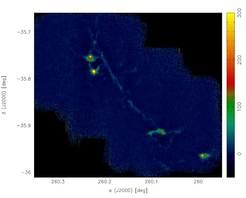
SABOCA, the Sub-millimeter APEX Bolometer Camera, is a bolometric continuum receiver for operation in the 350 μm atmospheric window. The receiver is based on an array of 39 superconducting bolometers with SQUID (Superconducting Quantum Interference Device) amplification and multiplexing.
Cooling
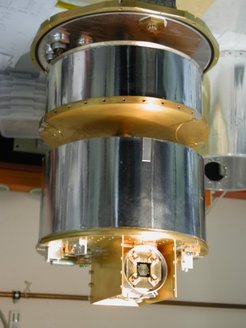
The bolometer array of SABOCA is designed to be operated at a temperature of about 300 mK. This temperature is reached by a Infrared Labs liquid Nitrogen / Helium cooled wet cryostat in combination with a single stage closed-cycle Helium-3 sorption cooler.
To operate the He-3 sorption cooler the bath temperature of the liquid helium system is reduced from 4K to 1.6K by continuously pumping on the helium bath. The hold time of the cryogenics as well as of the Helium-3 sorption cooler is about 48 hours.
The Helium pumping system and the operation of the sorption cooler have been automated and remotely controlled, allowing operation of the telescope during the cool down process (about 3 hours).
Detector Array
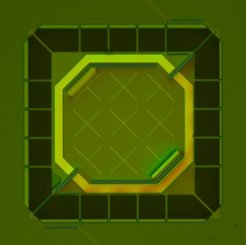
The bolometers of SABOCA are composite bolometers with superconducting thermistors on structured membranes. The superconducting thermistors, so called TES, Transition Edge Sensors, are bilayers of molybdenum and a gold-palladium alloy, deposited on the silicon-nitride membranes together with the niobium wiring and the radiation absorbing layer. IPHT has mastered to structure the membranes in order to control the thermal conductivity (see picture at the left). Several layouts have been studied, with different membrane structures, thermistors and absorbing elements.
The last generation of TES bolometers showed reproducible, steep transitions and smooth load curves. The bolometers of SABOCA have moderately structured membranes and showed at a transition temperature of 0.45 K a radiative NEP of 1.6 10-16 W/sqrt Hz) with a 300 K background during lab tests at MPIfR.
The full array of SABOCA consists of 39 TES bolometers; 37 are arranged in a hexagonal layout with of a center channel and 3 concentric hexagons. The two additional bolometers are identical but optically not coupled. These were added to the layout at two diametral opposite positions, for monitoring purposes.
A monolithic array of conical horn antennas with circular waveguides, acting as low-pass filter, is placed in front of the bolometer wafer. The 37 conical horns have been machined out of a single aluminum block at the machine shop at MPIfR. In combination with the tertiary optics, they guarantee an optimized optical coupling of the bolometers to the telescope.
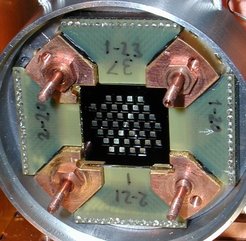
Readout
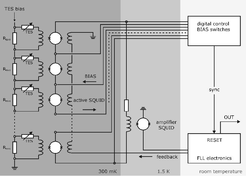
The TES bolometers are read out in a time domain multiplexing scheme using four independent SQUID amplifier/multiplexer chains with 10 channels each. The multiplexers and the associated electronics have been designed and manufactured by IPHT. The SQUID amplifiers are attached to the liquid helium cold plate and operated at the temperature of the pumped liquid helium (~1.6 K).
The 40 SQUID multiplexers, divided in four groups of ten, are located at the four sides of the bolometer array. They are operated at the same temperature as the bolometers (~300 mK). In order to operate the SQUIDs in a contaminated and unstable electromagnetic environment as the Cassegrain cabin of the APEX, a magnetic shielding is required. For SABOCA we use two stages:
- an envelope of high magnetic permeability metal (called mu-metal) covers most of the cryostat;
- a superconducting aluminium shield of the innermost parts.
Even between recycling-runs, while warming up the superconductive shield, the operation points of the SQUIDs stay constant.
The data acquisition software, running on the backend computer of LABOCA, collects the bolometer signals from the de-multiplexer and provides them via TCP data stream to the APEX control software. By use of the same bridge computer as LABOCA real-time digital signal processing (Fourier filtering, down-sampling) of the raw data is also possible, although not strictly required.
Spectral Response
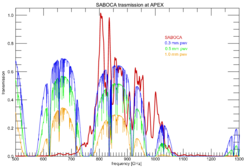
The figure below shows the pass-band of SABOCA compared to the atmospheric transmission at APEX for typical values of precipitable water vapor. The band is defined by a set of in-house fabricated filters and the cut-off frequency of the circular waveguides on the horn-antennas in front of the detectors.
Performance

TES bolometers are not sensitive to microphonics and therefore provide excellent signal quality even if operated in the rough telescope environment. Down to 10 mHz the signals of SABOCA do not show any 1/f noise (see the plot below).
The sensitivity of SABOCA was derived from blank-sky observations, after correlated noise removal. The mean array sensitivity was found to be ~1.4 Jy sqrt(s). The best bolometers have sensitivities of ~1.1 Jy sqrt(s). The array sensitivity is ~200 mJy sqrt(s).
The beam shape of SABOCA was determined from several beam maps on Mars. The main beam is almost spherical and has a de-convolved FWHM of 7.7″, close to the expected value of 7.5″. The beam starts to deviate from a Gaussian at a relative intensity of ~8% (11 dB).






